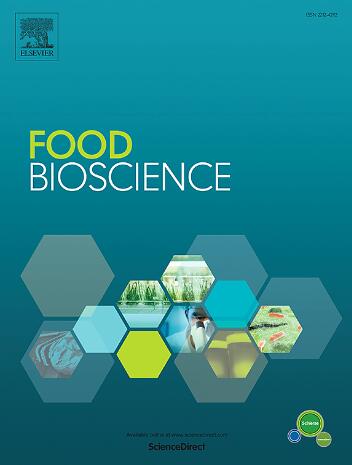复合调味酱质地变薄的机理研究:微生物的分离、鉴定和变质潜力评估
IF 5.9
1区 农林科学
Q1 FOOD SCIENCE & TECHNOLOGY
引用次数: 0
摘要
复合调味酱是一种中式半固态调味品,在餐饮中应用广泛。然而,它偶尔会在储存过程中经历质量恶化,通常表现为糊状物变薄,粘度降低。现有的调味酱研究主要集中在产气和风味变化方面的质量恶化。各种酱料质地降解的机制,特别是微生物活动在这一过程中的作用,仍然知之甚少。因此,我们收集了市售的纹理变薄的样品,并对其进行了理化和微生物特征分析。结果表明,液化酱油样品中还原糖和tca可溶性肽含量较高。通过选择性培养基培养和16S rRNA测序,成功分离出3株优势腐败菌,分别为解淀粉芽孢杆菌(B. amyloliquefaciens)、贝氏芽孢杆菌(B. velezensis)和海氏芽孢杆菌(B. haynesii)。代谢表型表征表明,这三种菌株都表现出强大的细胞外蛋白酶生产能力。解淀粉芽孢杆菌和海氏芽孢杆菌的淀粉酶活性显著高于贝氏芽孢杆菌(p < 0.05)。微生物接种实验发现,3株菌种均能显著提高还原糖和tca可溶性肽含量,最终使酱料贮存10天后粘度降低60% ~ 79%。本研究确定了复合调味酱质地变薄的关键微生物,为复合调味酱的质量控制提供了重要的指导。本文章由计算机程序翻译,如有差异,请以英文原文为准。

Elucidating the mechanisms of texture thinning in compound seasoning sauce: Microbial isolation, identification, and spoilage potential assessment
Compound seasoning sauce, a type of Chinese semi-solid condiment, is widely used in catering. However, it occasionally undergoes quality deterioration during storage, typically manifesting as thinning of the paste with reduction in viscosity. Existing studies regarding the seasoning sauce predominantly focused on quality deterioration in terms of gas production and flavor changes. The mechanisms underlying texture degradation for various sauces, particularly the role of microbial activity in this process, remain poorly understood. Thus, the commercially available samples with texture thinning were collected and analyzed for physicochemical and microbial characteristics. It was found that the liquefied sauce samples exhibited high levels of reducing sugar and TCA-soluble peptide. By employing selective medium cultivation and 16S rRNA sequencing, three predominant spoilage bacterial strains were successfully isolated and identified as B. amyloliquefaciens, B. velezensis, and B. haynesii. Metabolic phenotypic characterization demonstrated that all the three strains exhibited robust extracellular protease production capabilities. Notably, the amylase activities of B. amyloliquefaciens and B. haynesii were dramatically higher than that of B. velezensis (p < 0.05). Microbial inoculation experiments found that the three strains caused significant increase in reducing sugar and TCA-soluble peptide content, ultimately resulting in a 60 %–79 % reduction in sauce viscosity after 10 days of storage. This study identified the key microorganisms responsible for the texture thinning of compound seasoning sauce, providing critical guidance for the quality control of compound seasoning sauce.
求助全文
通过发布文献求助,成功后即可免费获取论文全文。
去求助
来源期刊

Food Bioscience
Biochemistry, Genetics and Molecular Biology-Biochemistry
CiteScore
6.40
自引率
5.80%
发文量
671
审稿时长
27 days
期刊介绍:
Food Bioscience is a peer-reviewed journal that aims to provide a forum for recent developments in the field of bio-related food research. The journal focuses on both fundamental and applied research worldwide, with special attention to ethnic and cultural aspects of food bioresearch.
 求助内容:
求助内容: 应助结果提醒方式:
应助结果提醒方式:


